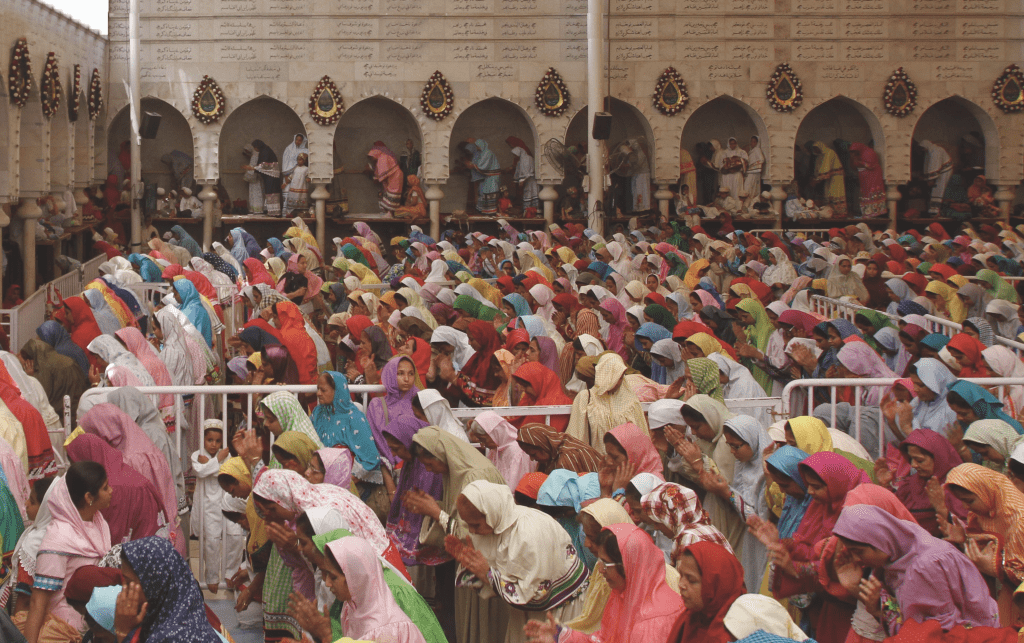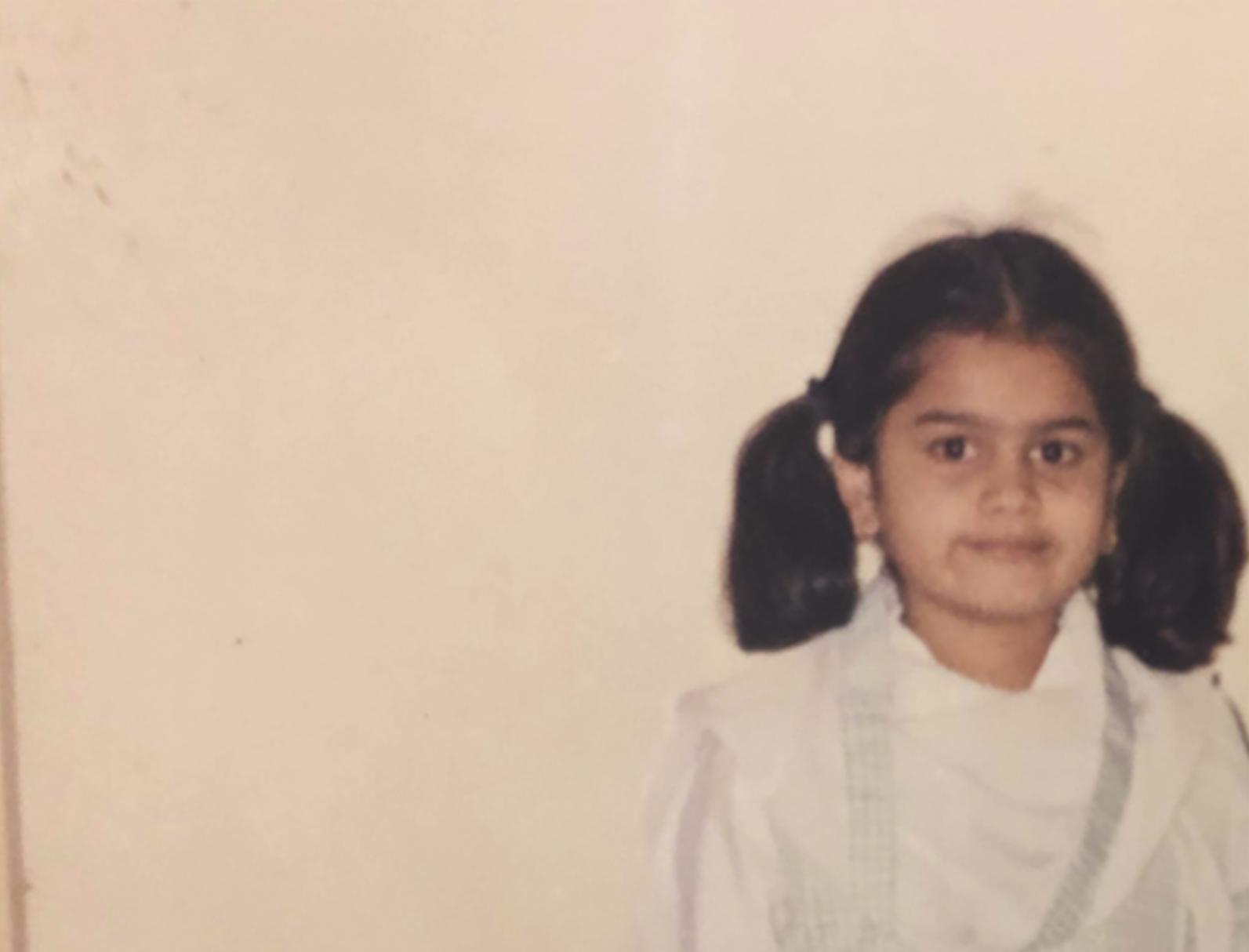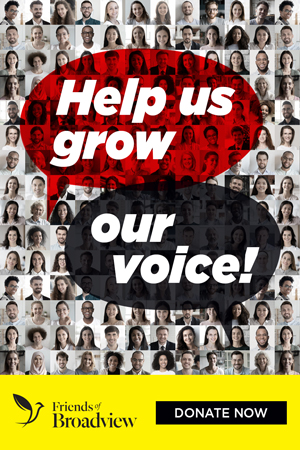Karachi, Pakistan, the city where I was born, was always hot, but the heat felt more intense that afternoon. The sun was holding nothing back. I was around seven years old, and I was accompanying my mom and grandma to an old building in a neighbourhood close to ours.
We took the stairs up to an apartment and knocked. Before the woman inside could even open the door, my hair was stuck to my forehead with sweat. The adults greeted one another with “salam,” a traditional phrase that means peace, and we walked in.
Soon, I found myself lying on the carpet with my legs spread apart. I was told to pull up my dress and look at the ceiling. I turned to my grandma, and she nodded in encouragement.
The woman’s fingers pulled down my underwear, and the carpet felt itchy on my skin. A ray of light coming through the curtains reflected off something shiny in her hand, but I couldn’t see what it was. I clenched my fists, and tears rolled down my face. When I bent my legs in response to a sharp pain, someone held them down.
After we got home, I asked my mom why I had to wear what felt like diapers. She told me that all girls have to go through this procedure because it was part of our religion and not to tell anyone. After a day or two, it stopped burning when I peed and the bleeding came to an end. My mother and I didn’t speak of it again, and I had no idea what happened to me in that stranger’s dark apartment. Instead, I stayed silent and tried not to think of it.
A few years later, in 2005, my family and I moved to Canada. We settled in easily, thanks to our tight-knit Dawoodi Bohra mosque in Toronto. I identify as a Dawoodi Bohra, a small sect within the branch of Shia Islam. The largest populations of this Muslim group live in South Asia, East Africa and the Middle East, but a significant number of us also live in Europe, North America and Australia.

Being Dawoodi Bohra, for me, comes with a rich history — one filled with colourful traditions, a sense of community and progressive teachings, especially in regard to higher education and leadership roles for women. However, this progressiveness conflicts with certain traditions that some people in my community continue to practise, including female genital mutilation or cutting (FGM/C).
I began to face these contradictions in 2017, when I was wrapping up my undergraduate studies in Toronto at Ryerson University. A friend shared an article on WhatsApp about the arrest of two doctors from our sect who practised FGM/C, known as khatna in our community, on young girls in Michigan. As I read the news piece, my body clenched up, like I was seven again.
Although the Qur’an doesn’t mention khatna, many Dawoodi Bohras believe the sacred Islamic text of Da’aim al-Islam cites it as compulsory. To normalize the secretive practice, arguments about health, hygiene and girls having the same rights to circumcision as boys are mentioned by pro-khatna groups, like the Dawoodi Bohra Women for Religious Freedom. They also argue that banning khatna is an infringement on their rights.
After the arrest of the Michigan doctors, more stories on this issue started to appear on my social feeds, and I reminded myself not to question what was essentially a part of our religion. I was afraid that doing so could jeopardize the basis of my identity. But I couldn’t help it; I became obsessed with the case. Thanks to the the internet, I could finally find answers to the questions swirling in my head.
First, I googled “FGM” because I wanted to know exactly what it was. According to the World Health Organization, FGM includes partially or fully removing the female external genitalia or otherwise injuring the female genital organs for non-medical reasons, such as cultural or religious purposes. I also saw diagrams that demonstrated cutting and sewing.
Distraught, I rushed into a bathroom stall at the library where I was doing my research, put the selfie side of my phone camera between my legs and tried to find any resemblance to what I’d just seen. There wasn’t one I could detect on the small screen. I thought a lot about going to the doctor to find out what exactly had been done to me. But I didn’t want to risk having my religion judged for outlawed practices. Plus, nothing physically hurt, so I didn’t see the point. What was taken away couldn’t be put back, I thought.
More on Broadview: My mosque is an empowering place for women
In my research, I also discovered that the term “female circumcision” has been criticized by the United Nations Population Fund for drawing a parallel with male circumcision. The physical and psychological health implications for women and girls are much more serious. The UN instead prefers the term “mutilation” to emphasize the gravity of the act and reinforce that it is a violation of women’s and girls’ basic human rights. In the late 1990s, the phrase “female genital cutting” was introduced since “mutilation” can imply that parents or practitioners perform this procedure maliciously. Some organizations use both terms.
The practice has been recorded in at least 30 countries. For many Canadians, FGM/C is a foreign term — something that happens in that part of the world. But it reportedly happens in Canada, too. In a 2016 Canadian Border Services Agency report, officers were given photographs of cutting tools, belts and “special herbs” to watch for in the baggage of people entering the country that might be used for the practice.
As well, in a 2017 study of 385 Dawoodi Bohra women, two of the 18 Canadian participants said that they had experienced a form of the procedure in Canada. The anti-FGM/C organization Sahiyo, which conducted the study, categorizes khatna as a social norm in which the tradition is passed down through generations without question. Mariya Taher, the co-founder of the NGO and the author of the study, grew up in the United States in a Dawoodi Bohra household and says she underwent the procedure on a trip to India when she was young. Taher says that even if parents don’t want their daughter to go through it, “there’s pressure from other people in the community.”
I haven’t heard of khatna happening in Canada. Many of my friends say they went through the procedure on trips abroad, just like Taher. This is called “vacation cutting.” My friend Tasneem* agreed to share her story under a pseudonym. The 23-year-old comes from a religious Dawoodi Bohra family in a suburb close to Toronto and remembers undergoing khatna in a home near her grandmother’s neighbourhood in Pakistan when she was very young. She thinks scissors were used and, like me, was later told it was for “religious purposes” by her mother. When the topic came up in Islamic school in her adolescent years, she wasn’t satisfied with the answer that it was to “suppress feminine proclivity.”
I know we’re so much more than this piece of tissue taken away from us.
Tasneem says she can masturbate, “but sometimes things will hurt,” and she’s fairly certain the localized pain is because of khatna. However, without a medical opinion, she has no way to know for sure, and she doesn’t like going to the doctor. Tasneem says she isn’t angry at her family members for having khatna done to her. She realizes these cultural practices were “spoon-fed” to them — her mother had it done, as did her mother’s mother, as a sign of faith and a requirement to be part of the sect. However, Tasneem says the family tradition ends with her — she won’t have it done to her future daughters.
When I asked why she hasn’t spoken up against the practice, she explains that anything sexual, especially about a woman’s body, is very taboo in the Dawoodi Bohra culture. She says the commandment to carry out FGM/C comes from lectures by higher-ups in the community, and religious arguments will always be used to silence questions. “There’s really no way for you to counter that,” says Tasneem. “So a lot of people just don’t see the point and are afraid of getting hit with that.”
Farzana Doctor is trying to break that silence. She is a Toronto author and psychotherapist, and a co-founder of the End FGM Canada Network and WeSpeakOut. The network urges the federal government to acknowledge that FGM/C is a problem here and advocates for Canada to take the lead on protecting girls around the world. Doctor, who underwent khatna on a trip to India as a child, had nightmares and flashbacks after realizing what was done to her. She says that the secrecy of the practice adds to the trauma: “Nobody explains [the procedure] to us and they urge us not to talk about it, so we can’t make sense of it.”
Most people who do khatna believe they’re only cutting the clitoral hood, but they sometimes damage the clitoris. Doctor says that FGM/C comes from a belief that a woman’s sexuality needs to be controlled. If sex is not enjoyable for a woman, she is less likely to cheat on her partner. “It causes damage to sexuality, but it also shames sexuality in a huge way,” she says.

Doctor identifies as Dawoodi Bohra but is not an active member of a congregation. She says change might be slow and that women need to start talking to other women, especially new mothers of daughters. She has heard of women lying to pro-khatna people about having it done to their daughters. This is a great way to resist, she says, but she wants these moms to be able to speak their minds on the issue. “The break in the cycle has to start somewhere.”
FGM/C is an offence under the Canadian Criminal Code, but no one has ever been prosecuted for it. Part of the difficulty in addressing FGM/C in Canada is the lack of information about the practice. The Ministry of Women and Gender Equality has provided more than $95,000 for qualitative research to shed light on FGM/C by studying perceptions among different cultural groups.
I know how difficult it is for Dawoodi Bohra women to speak up. I’ve tried to write this piece for years but trashed the document each time I started. I feared people viewing our sect in a negative light, and more so, being ousted from my community. But I’m doing this now because I don’t think khatna defines me or other Bohra women who’ve gone through the procedure. I know we’re so much more than this piece of tissue taken away from us.
I consider myself lucky to not have major complications from my procedure, but I wish it never happened. For a while, I carried some bitterness toward my mother. The trauma of knowing someone I love could hurt me as a child was hard to reconcile. When I recently asked her how she could watch that afternoon, she said she didn’t enter the room. “Your grandma was with you. I couldn’t see you like that,” she told me. And with that, something started to heal.
This story first appeared in Broadview’s March 2020 issue with the title “Unspoken.”
Broadview is an award-winning progressive Christian magazine, featuring stories about spirituality, justice and ethical living. For more of our content, subscribe to the magazine today.


Comments
Jeff Archambeault says:
Thank you Zahra and Farzhana for sharing and voicing and courage to speak your truths. May it influence change to happen.
Wendy Samaroo says:
A very empowering document for brown women in Canada to read. It makes me so angry that this was done to you, and yet, as an Indo-Trinidadian woman, I come from the same kind of family structure as you, and so I can easily empathise with you. Keep on writing, sister, and keep on changing the world one story at a time influencing so many of our own.
Sandra Streifel says:
I’m a European-descended Christian feminist, and I really appreciate this article authored by someone who’s experienced FGM/C because we have to talk about this more, without stigmatizing other cultures. Education is the way to make FGM/C history!